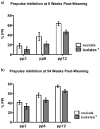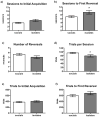Isolation rearing effects on probabilistic learning and cognitive flexibility in rats
- PMID: 23943516
- PMCID: PMC3923850
- DOI: 10.3758/s13415-013-0204-4
Isolation rearing effects on probabilistic learning and cognitive flexibility in rats
Abstract
Isolation rearing is a neurodevelopmental manipulation that produces neurochemical, structural, and behavioral alterations in rodents that in many ways are consistent with schizophrenia. Symptoms induced by isolation rearing that mirror clinically relevant aspects of schizophrenia, such as cognitive deficits, open up the possibility of testing putative therapeutics in isolation-reared animals prior to clinical development. We investigated what effect isolation rearing would have on cognitive flexibility, a cognitive function characteristically disrupted in schizophrenia. For this purpose, we assessed cognitive flexibility using between- and within-session probabilistic reversal-learning tasks based on clinical tests. Isolation-reared rats required more sessions, though not more task trials, to acquire criterion performance in the reversal phase of the task, and were slower to adjust their task strategy after reward contingencies were switched. Isolation-reared rats also completed fewer trials and exhibited lower levels of overall activity in the probabilistic reversal-learning task than did the socially reared rats. This finding contrasted with the elevated levels of unconditioned investigatory activity and reduced levels of locomotor habituation that isolation-reared rats displayed in the behavioral pattern monitor. Finally, isolation-reared rats also exhibited sensorimotor gating deficits, reflected by decreased prepulse inhibition of the startle response, consistent with previous studies. We concluded that isolation rearing constitutes a valuable, noninvasive manipulation for modeling schizophrenia-like cognitive deficits and assessing putative therapeutics.
Conflict of interest statement
No other authors have any potential conflict of interest to declare.
Figures








References
-
- Agid O, Shapira B, Zislin J, Ritsner M, Hanin B, Murad H, et al. Environment and vulnerability to major psychiatric illness: a case control study of early parental loss in major depression, bipolar disorder and schizophrenia. Mol Psychiatry. 1999;4(2):163–172. - PubMed
-
- Bakshi VP, Geyer MA. Ontogeny of isolation rearing-induced deficits in sensorimotor gating in rats. Physiol Behav. 1999;67(3):385–392. - PubMed
-
- Bakshi VP, Swerdlow NR, Braff DL, Geyer MA. Reversal of isolation rearing-induced deficits in prepulse inhibition by Seroquel and olanzapine. Biol Psychiatry. 1998;43(6):436–445. - PubMed
Publication types
MeSH terms
Grants and funding
LinkOut - more resources
Full Text Sources
Other Literature Sources

